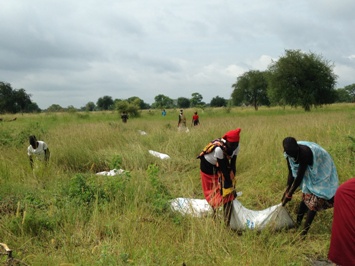Food gap widens in conflict-hit South Sudan: UN agencies
April 5, 2016 (JUBA) – Civil strife and unfavourable rains have further reduced crop production in South Sudan, contributing to a cereal deficit of 381,000 metric tons, 53% greater than in 2015, thus aggravating the already severe food shortages, an assessment by two UN agencies showed.

The crisis in South Sudan is marked by alarming levels of hunger. Some 5.8 million people, or nearly half of the country’s population, are unsure where their next meal will come from, while the rate of severe food insecurity has now reached 12 percent, double the rate of one year ago.
“South Sudan is facing a deadly blend of conflict, economic hardship and poor rains. Together, they are worsening a hunger gap that we fear will force more people to go hungry and increase malnutrition,” WFP Country Director, Joyce Luma said Tuesday.
“This report makes it clear that improving the food situation requires a peaceful resolution to the conflict,” she added.
Over the two year of the country’s conflict, South Sudanese families have been forced to cope with soaring cereal prices, driven by a combination of the sharp devaluation of the local currency and higher transport costs.
Links between cereal-producing areas – mostly in the Equatoria and Bahr el-Ghazal states – and main markets have become extremely difficult due to heightened insecurity, a proliferation of roadblocks and exorbitant ad hoc taxes levied on commercial transporters along major trade routes.
“Food insecurity has spread to areas previously considered relatively stable, highlighting the cumulative impact of conflict, economic downturn and climactic shocks,” said Serge Tissot, FAO Representative in South Sudan.
Accorfing to the official, despite the huge potential for agricultural production, with more than 90% of South Sudan’s arable land, only 4.5% of available land was under cultivation when the country gained independence in 2011.
“Now, after over two years of civil war, this percentage has significantly decreased due to widespread insecurity, damage to agricultural assets and limitations in traditional farming methods,” said Tissot.
“Yet crop production is possible in the stable areas within conflict-affected states, and is more important than ever. Communities cannot rely on markets or aid deliveries for food, and therefore need to produce on their own,” he added.
The report, among others, recommends immediate action to address hunger, strengthen domestic food production and reduce the food gap in 2016 and into next year.
This year, however, FAO and WFP, together with their partners, will reportedly support efforts that aim to increase food availability, strengthen livelihoods and build resilience.
Despite WFP’s plans to provide food assistance and specialized nutrition support for about 3 million people in South Sudan in 2016, the agency says it still faces a funding gap of 241 million for the next six months.
(ST)
